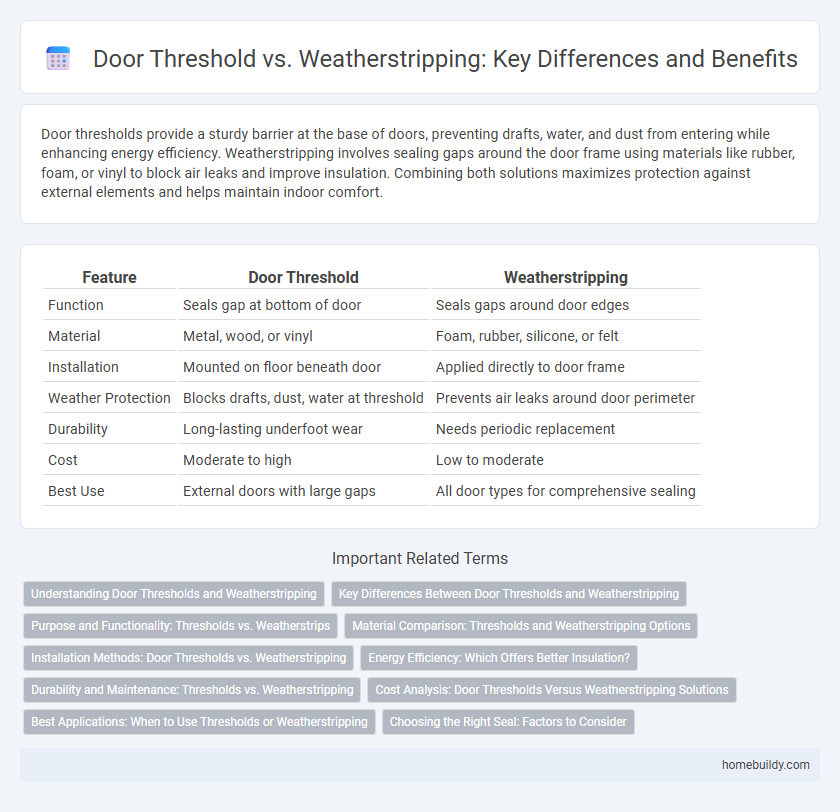Door thresholds provide a sturdy barrier at the base of doors, preventing drafts, water, and dust from entering while enhancing energy efficiency. Weatherstripping involves sealing gaps around the door frame using materials like rubber, foam, or vinyl to block air leaks and improve insulation. Combining both solutions maximizes protection against external elements and helps maintain indoor comfort.
Table of Comparison
| Feature | Door Threshold | Weatherstripping |
|---|---|---|
| Function | Seals gap at bottom of door | Seals gaps around door edges |
| Material | Metal, wood, or vinyl | Foam, rubber, silicone, or felt |
| Installation | Mounted on floor beneath door | Applied directly to door frame |
| Weather Protection | Blocks drafts, dust, water at threshold | Prevents air leaks around door perimeter |
| Durability | Long-lasting underfoot wear | Needs periodic replacement |
| Cost | Moderate to high | Low to moderate |
| Best Use | External doors with large gaps | All door types for comprehensive sealing |
Understanding Door Thresholds and Weatherstripping
Door thresholds provide a sturdy barrier at the base of doors to prevent drafts, water, and pests from entering, enhancing energy efficiency and comfort. Weatherstripping seals the gaps along door edges, complementing thresholds by blocking air leaks and improving insulation. Together, they form an effective system for maintaining indoor temperature and protecting against external elements.
Key Differences Between Door Thresholds and Weatherstripping
Door thresholds provide a physical barrier at the base of a door, preventing drafts, water, and pests from entering, while weatherstripping seals gaps around the door frame to enhance energy efficiency and reduce air leakage. Thresholds are typically made from durable materials like aluminum or wood, offering structural support and protection against external elements. Weatherstripping comes in flexible materials such as rubber, silicone, or foam, designed for easy installation and creating an airtight seal to improve indoor comfort.
Purpose and Functionality: Thresholds vs. Weatherstrips
Door thresholds provide a solid barrier at the bottom of doors, sealing gaps to prevent air, water, and pest infiltration while supporting the door's weight and ensuring smooth operation. Weatherstripping consists of flexible materials applied around door frames to create a tight seal that minimizes drafts, enhances energy efficiency, and reduces noise transmission. Both components work together to improve insulation and protect interior spaces from external elements.
Material Comparison: Thresholds and Weatherstripping Options
Door thresholds are typically made from durable materials like aluminum, wood, or composite to provide structural support and seal the gap beneath the door. Weatherstripping options include foam, rubber, vinyl, or silicone, offering flexibility and compressibility to block drafts and moisture. Comparing materials, thresholds prioritize rigidity and longevity, while weatherstripping focuses on elasticity and tight sealing for energy efficiency.
Installation Methods: Door Thresholds vs. Weatherstripping
Door thresholds require precise fitting into the door frame with screws or adhesive to ensure a secure, durable seal, typically involving carpentry tools for accurate alignment. Weatherstripping installation varies by material but often involves self-adhesive strips, foam tapes, or V-strip metals applied directly to the door edges or frame for quick, flexible sealing. Thresholds provide a structural barrier against drafts and moisture at the floor, while weatherstripping offers adaptable sealing around the door perimeter to block air leaks and improve energy efficiency.
Energy Efficiency: Which Offers Better Insulation?
Door thresholds create a solid seal at the base of a door, significantly reducing drafts and heat loss, which enhances overall home energy efficiency. Weatherstripping complements by sealing gaps around the door frame, but thresholds provide a more substantial physical barrier to air infiltration. Combining both door thresholds and weatherstripping yields optimal insulation and maximizes energy savings.
Durability and Maintenance: Thresholds vs. Weatherstripping
Door thresholds offer superior durability compared to weatherstripping, often crafted from robust materials like aluminum or wood that withstand heavy foot traffic and environmental wear. Weatherstripping typically requires more frequent replacement due to material degradation such as cracking or compression from temperature changes. Maintenance for door thresholds involves occasional cleaning and realignment, whereas weatherstripping demands regular inspection and replacement to maintain effective sealing.
Cost Analysis: Door Thresholds Versus Weatherstripping Solutions
Door thresholds generally involve a higher initial cost due to materials like aluminum or wood and professional installation, typically ranging from $50 to $150, while weatherstripping solutions offer a more budget-friendly option with prices between $10 and $30 for DIY application. Over time, weatherstripping may require frequent replacement every 1-3 years due to wear and tear, increasing long-term expenses, whereas durable door thresholds provide a more permanent seal, reducing maintenance costs. Evaluating both options, door thresholds deliver better return on investment in terms of energy savings and durability despite the higher upfront cost compared to lower-priced, short-term weatherstripping solutions.
Best Applications: When to Use Thresholds or Weatherstripping
Door thresholds provide a solid barrier ideal for exterior doors where sealing against drafts, water, and pests is critical, especially in high-traffic entryways. Weatherstripping excels on interior and exterior doors with smaller gaps, effectively reducing air infiltration and improving energy efficiency. Choosing a threshold or weatherstripping depends on gap size, exposure to elements, and desired durability for optimal door sealing performance.
Choosing the Right Seal: Factors to Consider
Choosing the right seal between a door threshold and weatherstripping depends on factors like climate, door type, and energy efficiency goals. Door thresholds provide a durable barrier against drafts, dust, and water, ideal for exterior doors exposed to harsh weather. Weatherstripping offers flexible, easy-to-install sealing solutions suited for gaps around door frames, enhancing insulation and reducing air leakage in various door applications.
Door threshold vs Weatherstripping Infographic

 homebuildy.com
homebuildy.com